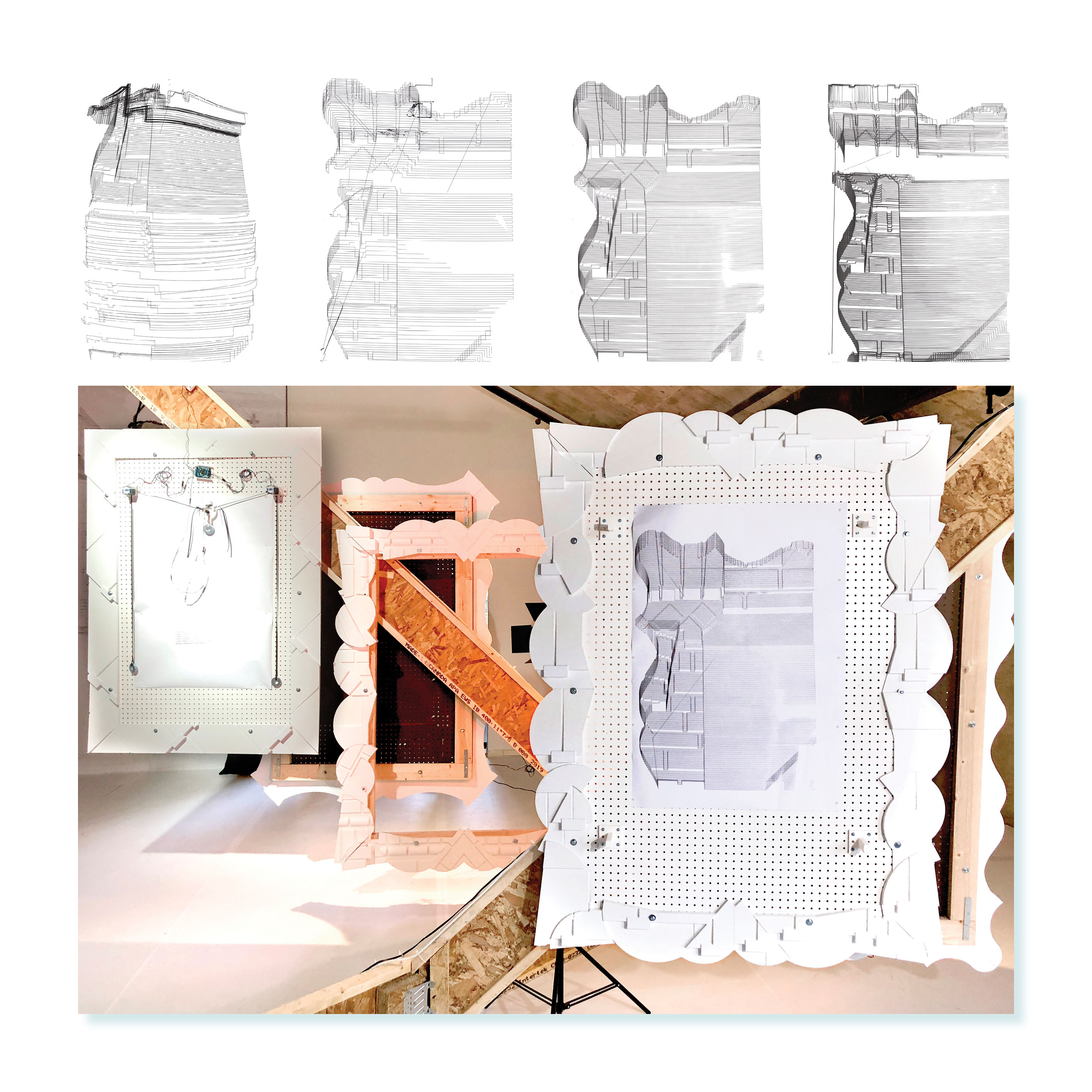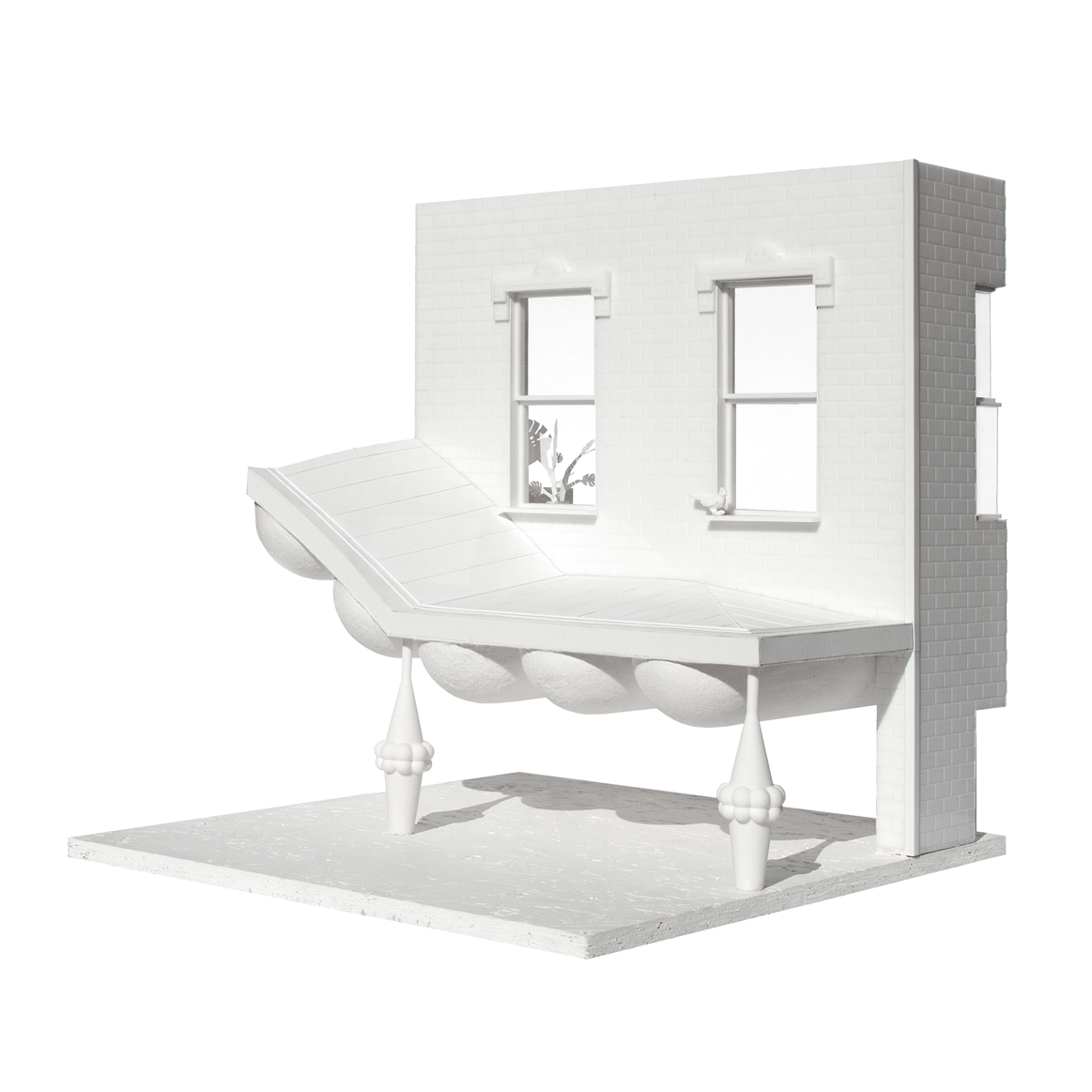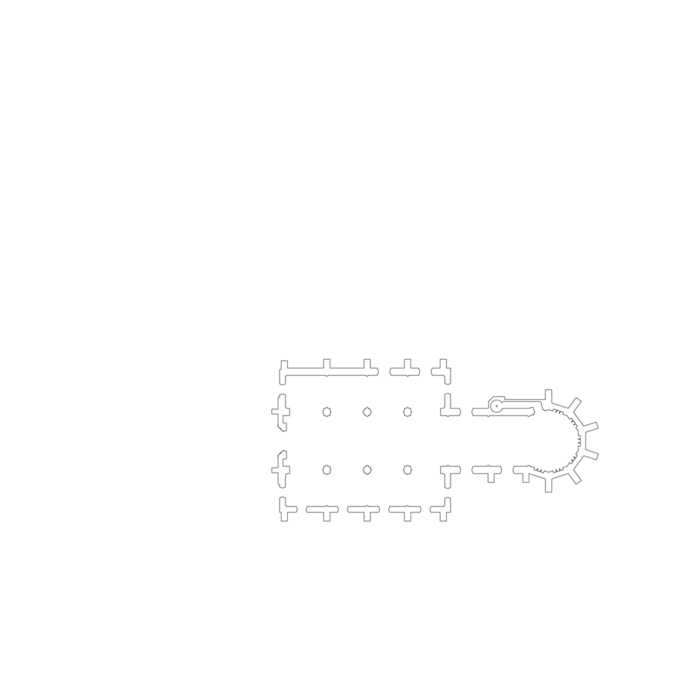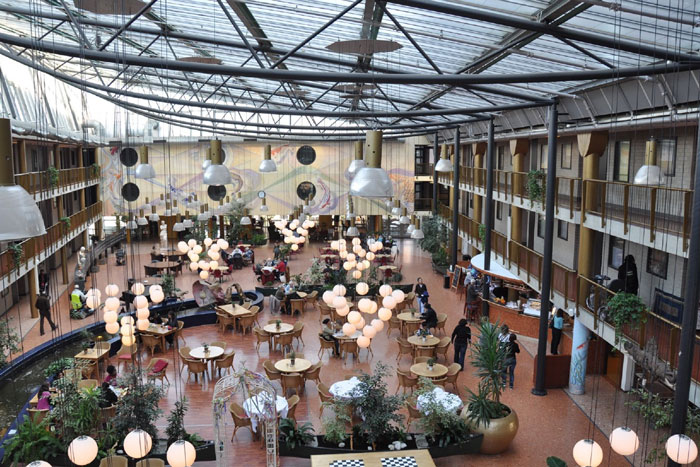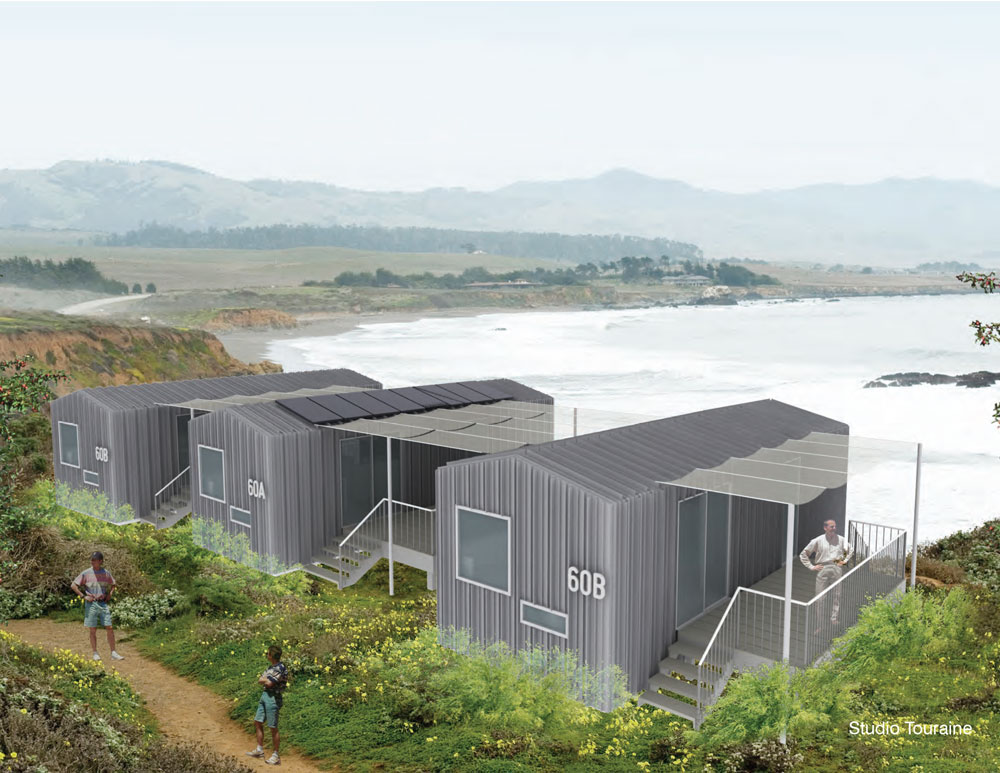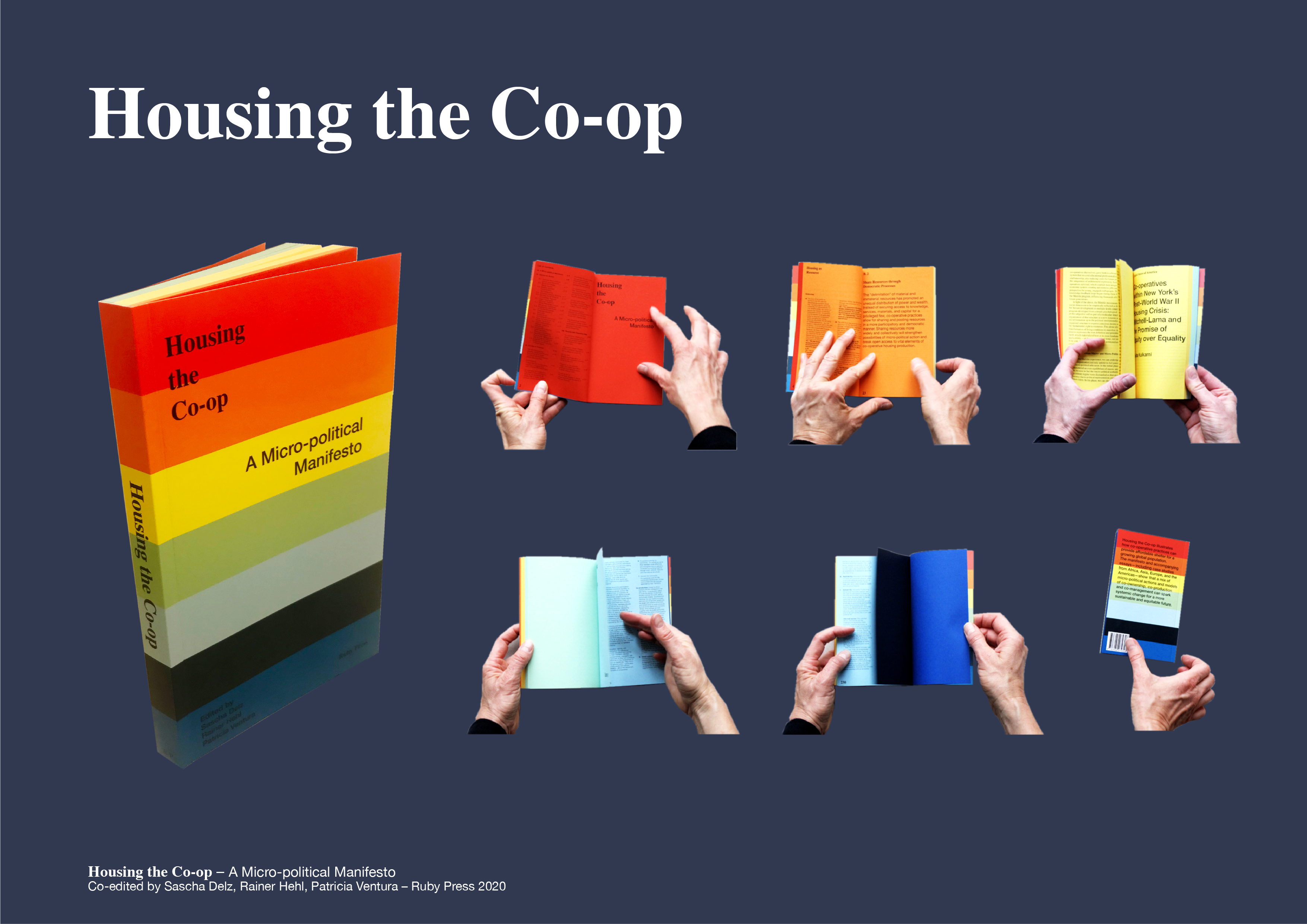
The USC Architecture Faculty/Student Exhibition Series is an exhibition program that profiles the work of a faculty member along with a selection of student projects from their studio or seminar. The intent is not only to highlight their professional work or academic research but also to offer insights into connections between their pedagogy and practice.
Spring 2021 Exhibitions
Drawing Drawings
By Emily Mohr Originally exhibited at The Ohio State University’s Banvard Gallery, “Drawing Drawings” was the performance of a series of nine ‘as-built drawings’ exhibited as they were drawn in the Banvard Gallery. Neither digitally fabricated nor hand-crafted, the exhibition employed a series of custom-built CNC drawing robots to draw nine drawings framed perspectivally and literally by nine frames. Composed of recompositions of site-specific ornament, the framed drawings were suspended from three structural members mismatched from the gallery’s three existing structural channels to produce a series of collaged views of the collaged frames.
ViewFour Corners, Redux
By Melissa Shin This exhibition, originally exhibited at the Wedge Gallery of Woodbury University, explores resolution and hybridization for a series of four transformed historic homes in Detroit, Michigan. Since we are not able to show the built models in person, they have been LiDAR scanned for online viewing. The original digital model used to construct the physical model lies beneath a low-resolution LiDAR scan of the built physical model – the loss through digital translation produces a new reading of the model’s scale and details wherein walls and columns begin to dissolve.
ViewTangibility of the Gaze, Notes on Ayeneh Kari
By Farnoosh Rafaie Formed within the 17th Safavid era in Persia and re-formed through the sublime works of Monir Farmanfarmaian, Ayeneh Kari inscribes pure, hyper tessellated geometry through the interplay of light and reflection. Absurdly disparate in its formation, these mirror mosaics exhibit the dynamic overcoating of figure within figure through identifiable consciousness. This exhibition chooses to display just a few sourced contemplations on figures built from two dimensional cosmic geometry to “three dimensional” digital sculpture noting how these dazzlingly figures can be absorbed through the familial presence of one’s own image.
ViewMisreading as a Model for Reconstruction
By Juan Salazar The work addresses themes of historic reconstruction in a sensitive urban and political context. At a time when the consciousness and meaning of the past in the urban context is shifting— finding new life in the old formulas of preservation, and understanding reconstruction as an inventive act. This work was originally presented at the 2018 exhibition
ViewHousing Options for Physically and
Mentally Frail Older People that Promote Independence
By Victor Regnier, FAIA In the next 30-50 years the demographic profile of the US and the World will change radically as life expectancy grows and fertility contracts pushing the average age higher. Beyond the economic impacts this has on productivity and economic growth, it also has a major impact on humanity. While countries in northern Europe have developed community-based alternatives to combine independent housing and services, the US has continued to promote institutional models. This exhibit explores through various design approaches three housing and service hybrid models that provide support to the mentally and physically frail in an independent non-institutional fashion. This exhibit displays work from Professor Victor Regnier's latest book on more humane alternatives to institutionalizing mentally and physically frail older people.
ViewFall 2020 Exhibitions
Designing at Fairy Scale
By Takako Tajima Fairy gardens are generally comprised of live plant material and fairy garden accessories (i.e. fairy figurines, tiny houses, little gates and fences, and petite furniture) to create an environment at a miniature scale for its imagined fairy residents. Lecturer Tajima was motivated to design fairy gardens because they have a unique capacity to be conceived at multiple scales simultaneously. Like fairies, the fairy scale is strange and magical. The gardens are created at 1:1 fairy scale. However, they are also to be enjoyed purely for its 1:1 planting design AND can serve as a scaled model for imagining new landscapes and architecture for human beings. According to her research, fairies range in height from 2 ½” to 3” so fairy gardens can be perceived at approximately ½” = 1’-0”.
ViewRethinking “manufactured homes”
By Olivier Touraine Studio Touraine was contacted by a large “manufactured home” company to improve design and energy autonomy for its line of products in three assembly factories in the U.S. The purpose was to target a new market of co-shared weekend or vacation homes for an urbanite population, possibly located in very diverse landscapes. All components were identified and modified. The roof and external wall were clad with one unified material, optimizing the look and reducing the number of trades involved in the manufacturing.
ViewSavage Mind to Savage Machine: Design, Racial Science, and the Ergonomics of the Spirit
By Ginger Nolan This exhibition is based on a forthcoming book, Savage Mind to Savage Machine: Racial Science and Twentieth-Century Design. This historically researched study addresses a gap in existing literature on modernist primitivism by revealing discursive connections between technologically oriented design practices, a preoccupation with so-called “primitive” thought, and constructions of race. Professor Nolan hopes that viewers will be encouraged to consider various strains of design history in light of these connections.
ViewHousing the Co‑op – A Micro‑political Manifesto
By Sascha Delz This exhibition shows excerpts from Housing the Co‑op – A Micro‑political Manifesto, a publication co-edited by Sascha Delz, Rainer Hehl and Patricia Ventura, and based on a research project conducted over the past three years. Housing the Co-op illustrates how co-operative practices can provide affordable shelter for a growing global population. The manifesto and accompanying essays — including case studies from Africa, Asia, Europe, and the Americas — show that a mix of micro-political actions and models of co-ownership, co-production and co-management can spark systemic change for a more sustainable and equitable future.
View